It Makes Psychological Sense If You Weirdly Care a Lot About Brangelina’s Divorce
For more celebrity videos visit Yahoo View, available now on iOS.
By Drake Baer
Angelina Jolie is divorcing Brad Pitt, citing “irreconcilable differences.” The theories floated thus far say that it could be a case of Pitt’s “parenting style” upsetting Jolie, that he’s smoking too much weed, and/or that Jolie has her sights set on pursuing a seat in the British House of Lords, which seems like a satisfyingly Angelina thing to do. As humanity processes the news, Twitter is going nuts, and staid publications are publishing roundups of the social-media furor.
Related: Every Theory About the Brad Pitt-Angelina Jolie Divorce
From a psychology standpoint, all the sadness and schadenfreude are indicative of the “parasocial relationships” that people have with celebrities. The researchers Donald Horton and Richard Wohl coined the term in a 1956 paper, arguing that the advent of mass media created a one-sided “intimacy at a distance.” For actors — such as Brad and Angelina — a sort of fusion takes place between the characters they play onscreen and the personae they communicate in media. This was different back in the day when theater was the main form of drama, the researchers contended: The “confusion of identities” was temporary, since after the final bow, the actor goes back to the “matter-of-fact,” IRL world. But radio and television have fiction and real life in “continuous interplay,” they write. Radio and television “are alternately public platforms and theatres, extending the para-social relationship now to leading people of the world of affairs, now to fictional characters, sometimes even to puppets anthropomorphically transformed into ‘personalities’, and, finally, to theatrical stars who appear in their capacities as real celebrities,” they write. Despite the weird shade thrown on puppetry, Horton and Wohl hit the nail on the head regarding how normals relate to movie stars. We see them as a conflation between character and person; celebrity lies somewhere in between.

Photo: Everett Collection
Related: A Comprehensive Timeline of Brangelina’s Relationship
More recent research has expanded on this finding, like that the TV shows that people love make them feel less lonely, and that when a favorite TV series goes off the air, viewers feel like they’re losing a real-life friendship. Even if the relationship is “fake” in a literal sense, the emotions are experientially real. This is why the return of Gilmore Girls will delight moms and daughters across the country, and why Game of Thrones so adroitly rips your heart out with beloved character death after beloved character death, season after season. “Story worlds allow us to explore our own identities, our own understandings of our relationships, our values, what we think is meaningful in life,” media psychologist Karen Dill-Shackleford told Science of Us earlier this year. What makes the de-Brangelization even more interesting is that, though they met on the set of Mr. & Mrs. Smith, Jolie and Pitt were a real-life couple.
Related: Jennifer Aniston Is Better Than Fine, She’s GREAT
For audiences, celebrities are a lot like fictional characters: We receive them through media, and form conceptions of their personalities without ever meeting them. As Alana Massey put it for Pacific Standard, people form imaginary (and meaningful) relationships with celebrities, along the same lines as fictional characters. Celebrities shape how young people conceive of relationships and their individual sense of self, research indicates, and a 2006 study found that 75 percent of young adults said they had “strong attachments” to two or more celebs. In their 79-person sample, the admirer-idol relationship was frequently marked by youths feeling like they shared the same values as their icons, feeling inspired by their work ethics, and being led to “undertake a variety of pursuits such as creative writing, becoming a vegetarian, or smoking marijuana.”
Even before social media, people’s celebrity allegiances were identity signifiers — recall the Team Aniston and Team Jolie shirts that sprang up in the mid-’00s, back when Pitt broke up with Jennifer Aniston and got with Jolie. (But in 2016, instead of buying shirts, we make GIFs. ) In a way, Jolie and Pitt represent an old guard of celebrity, the kind that didn’t skewer rivals by way of a Snapchat story. With the advent of the reality star, the boundary between the icon and the admirer is getting muddier. Which means if Kim and Kanye ever break up, all hell will break loose.
More from Science of Us:
Angelina’s Divorce Shows How ‘Failed Marriages’ Are Failing Us
How to Write Your Way Out of An Emotional Funk
Tinder’s In-house Sociologist Has Some Very Good Advice
Why Being Beautiful and Being a Jerk Seem to Go Hand in Hand

